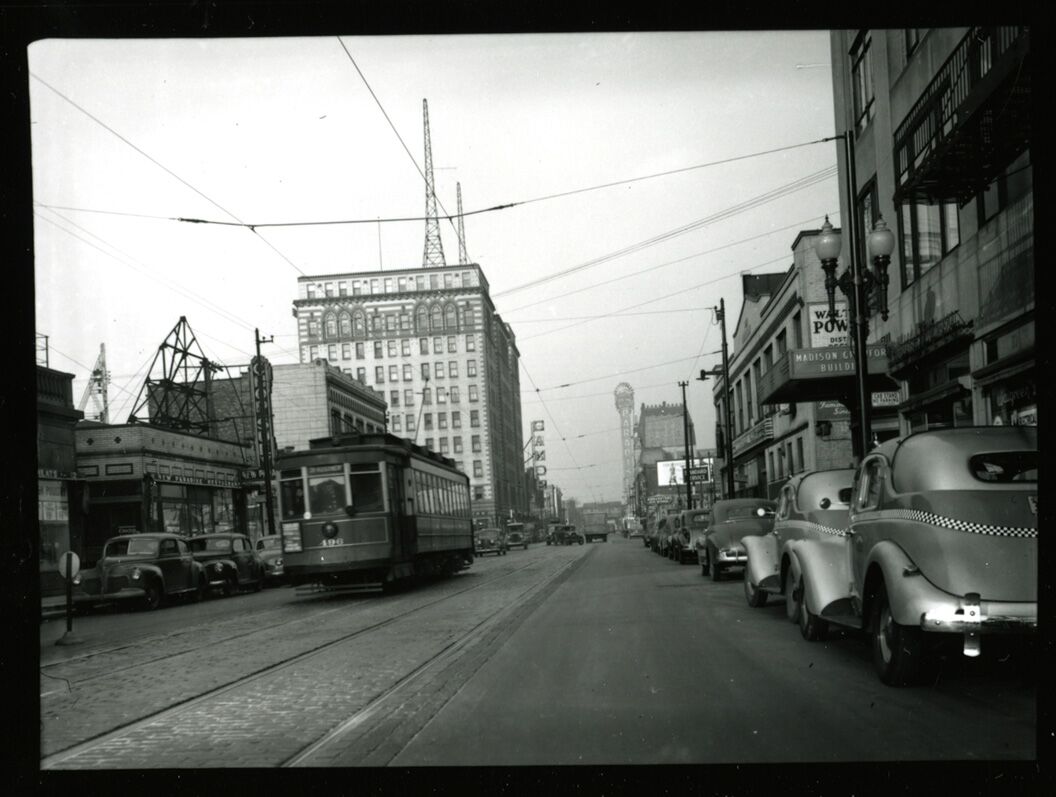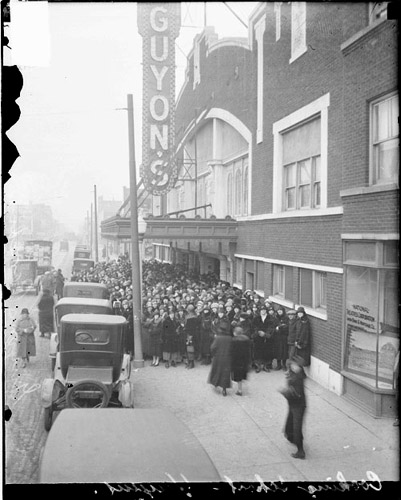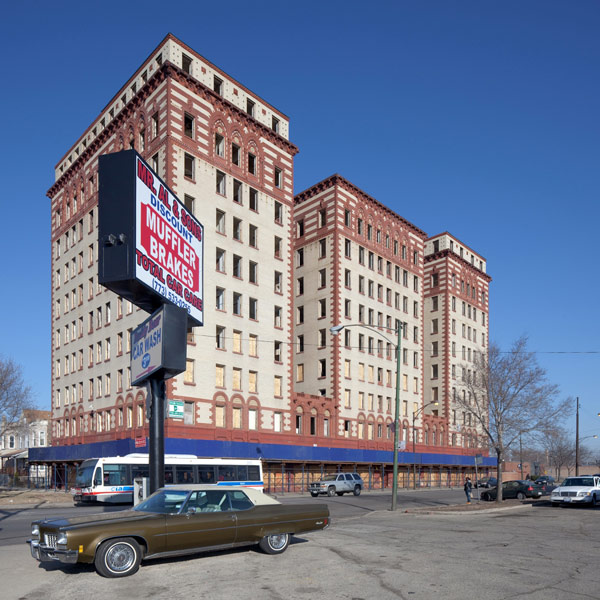The Guyon Hotel
The Quest for Landmark Status
The profile of the Guyon Hotel, relatively well-kept in the 1980s and in disrepair today.
Jens J. Jensen Jazz Architect

An archival sketch illustrates the architectural highlights of Jens J. Jensen's Jazz Age marvel. (Courtesy of Bethel New Life)
The firm owned by Jens J. Jensen, not to be confused with the famous Chicago landscape architect Jens Jensen, built the Guyon Hotel from 1927 to 1928. The hotel was one of four major post World War I projects in West Garfield Park, along with an athletic club, a library and a bank.
Jensen’s design was emblematic of Jazz Age passions and exoticism. He draped the building in tan and rouge terracotta tiling and decorated the windows, especially on the second and ninth floors, with detailed, ornamental tilework. The eclectic mix of patterns and icons around the building suggest a mix of Moorish, Venetian and Spanish Colonial Revival styles.

This colorized photo depicts the hotel at its absolute zenith in the 1920s. Note its distinctive ornamentation and coloring. (Courtesy of Jarrett Jensen)
Jensen designed buildings across Chicago for 50 years. During the Jazz Age, while people could afford it, his buildings all had the same noticeably lavish style like the Guyon Hotel, usually with terracotta tiling and ornamentation. He was often contracted to build pleasure projects like the hotel and, most famously, the Pioneer Arcade on the West Side.
The hotel was one of the first residential hotel buildings in a middle class neighborhood in Chicago, where tenants could rent out rooms for long-term stays. It paved the way for the popularity of similar residential hotels in the coming decades.
West Garfield Park Population
1930:50,014
The Guy Behind the Guyon

Pulaski Road, Chicago, IL, 1941-1942. Earl H. Reed, photographer. Jens J. Jensen, Architect. Historic Architecture and Landscape Image Collection, Ryerson and Burnham Archives, The Art Institute of Chicago. Digital File # U527439
French-Canadian real estate mogul J. Louis Guyon built the Guyon Hotel in 1928 as a 169-unit residential hotel, after making his name 14 years early with Guyon’s Paradise Ballroom just north of the hotel.
Also a dance instructor, Guyon took it upon himself to save Chicago from the seductive immorality of jazz culture with his 4,000-person dance club hosting only the most wholesome of dance styles and music. The Paradise Ballroom outright banned suggestive dances like the fox-trot and Charleston and, god forbid, the shimmy.

Louis Guyon dances with his wife on top of his eponymous hotel. (DN-0008331, Chicago History Museum, Chicago Daily News negatives collection)

Outside Louis Guyon's theater, just across the street from the hotel. (DN-0080116, Chicago History Museum, Chicago Daily News negatives collection)
The Guyon Hotel was also home to AM and then FM radio towers that broadcasted Guyon’s wholesome multilingual radio station, WGES, which later aired the predecessor to classical music station WFMT. The original studios were in the second floor ballroom.
1928 was hardly an ideal time to open a massive hotel and broadcasting headquarters, however, and Guyon sold the hotel in 1934. Adding insult to injury, during this time, Al Capone mobster, Jack McGurn, was busted at his apartment in virtuous Mr. Guyon’s hotel.
West Garfield Park Population
1940:48,447 (-1,567 from 1930)
West Side Woes

The Guyon Hotel with blown-out windows and boarded-up storefronts. (Courtesy of Landmarks Illinois)
Along with the rest of West Garfield Park, the Guyon Hotel struggled with a long period of decline and disinvestment. The Great Depression along with institutionalized discriminatory lending (or redlining) and neglectful, exploitative landlords crippled the increasingly African-American neighborhood’s economy.
The neighborhood was racially isolated and stigmatized, and the population, and the 1968 race riots after Martin Luther King, Jr.’s death, centered near the Guyon Hotel on the Madison-Pulaski intersection, took a devastating toll on West Garfield Park’s infrastructure and already dwindling population. The effects are still gravely apparent today.
One nonprofit organization, Bethel New Life, rooted itself in the community in an effort to support and reinvigorate the community. It came to the rescue of the Guyon Hotel in the process.

The interior of the Guyon Hotel, as Bethel New Life found it. (Courtesy of Bethel New Life)
West Garfield Park Population
1960:45,611 (-2,836 from 1940)
Saved by the Bethel
AUDIO: Mary Nelson remembers renovating the Guyon Hotel, with some help from President Jimmy Carter.
In 1985, Bethel New Life, a community support nonprofit on the West Side, purchased the decaying Guyon Hotel. Under Executive Director Mary Nelson’s watch, they began renovations to turn it into the crown jewel of a wide-ranging project to revitalize the neighborhood.
“This building was the gateway to West Garfield Park,” Nelson said. “It was a real symbol.
Bethel took advantage of new tax credits and financing tools to build 114 units of multifamily housing, with two penthouses and mixed-use storefronts on the ground level.

Courtesy of Bethel New Life
During the renovation process, Nelson got Habitat for Humanity and mega-booster President Jimmy Carter to come work on the project. Carter’s family stayed in an unfinished unit in the heat of summer.
“The Secret Service couldn’t believe that he was going to stay there,” Nelson said. “Carter built these four homes on Maypole. They called it the Miracle on Maypole.”
The Guyon Hotel’s second coming as a supportive housing building faded quickly as financing ran out for Bethel. In the early 1990s, Bethel lost control of the building to the Chicago Equity Fund.
“It’s a big regret that a beautiful building like that is sitting empty and not a place for people to live,” Nelson said.

A flyer from the grand re-opening of the Guyon Hotel as a supportive housing building. (Courtesy of Bethel New Life)
West Garfield Park Population
1980:33,865 (-11,746 from 1960)
Doomed for Demo?

Terracotta bricks are chipping off of the historic front of the Guyon Hotel. (Marisa Endicott/MEDILL)
Though Bethel managed to get the Guyon listed on the National Register of Historic Places (NRHP), attempts to get landmark status for the hotel have been less successful. For you architecture nerds, here is the Guyon’s original NRHP nomination form from 1985.
The Guyon Hotel made Landmarks Illinois' Ten Most Endangered Historic Places list in 2012 and Chicago Preservation’s “Chicago 7” list of most endangered buildings in 2013 and 2014, but the director of advocacy at Landmarks Illinois, Lisa DiChiera, said Chicago landmark status is a long shot because of the structure’s state of decay and a resting demolition order by the city. On the flipside, demolition would be so expensive at this point that the city is unlikely to take action, so the poor Guyon Hotel languishes on in limbo.
The Guyon’s best chance for survival is for a (very) well-funded organization to rehab the building taking advantage of tax credits available for NRHP structures. Holsten Development Corp., an innovative affordable housing developer, just did a great job with the Midwest Athletic Club. Just sayin.’

Marisa Endicott/MEDILL
West Garfield Park Population
2009-2013:18,715 (-15,150 from 1980)
Cool and/or Useful Sources
Landmarks Illinois, especially Lisa DiChiera
“A short history of Chicago’s beautiful decrepit Guyon Hotel” Chicago Magazine
“Ask Geoffrey” WTTW
“Redlining” "West Garfield Park" Encyclopedia of Chicago
Bethel New Life, especially Mary Nelson
Jensen and Jensen, especially Jarrett Jensen